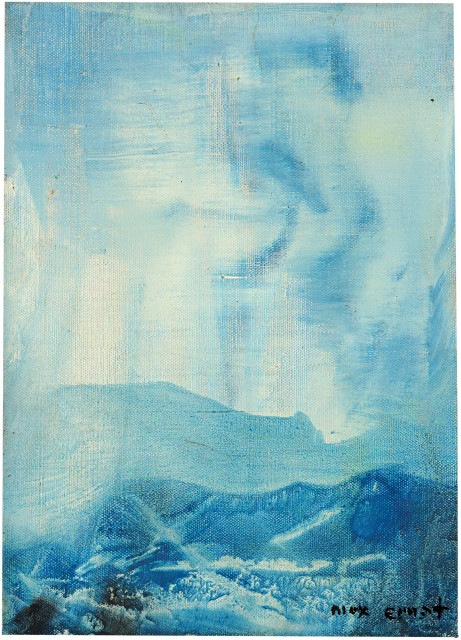- EN
Log in
- Live Auctions
- Past auctions
- More
- Gallery
- Art Dealing
- Publishing
- Kornfeld today
- The Story of Kornfeld
- Information





Brühl 1891 - 1976 Paris
circa 1955
Oil on canvas
22x16 cm
Signed on the lower right by the artist "Max Ernst"
Werner Spies/Günter Metken, Max Ernst, Werke 1954-1963, Cologne 1998, no. 3110
Galerie Pierre Loeb/Edouard Loeb, Paris
Collection Walther Scharf, Oberstdorf, from there to
Dr. Ewald Rathke, Frankfurt am Main, acquired there from
Collection Dr. Hans Feith, Frankfurt am Main, from there to
Dr Hans and Dr Elisabeth Feith Foundation, Frankfurt am Main
On the original stretcher in the original nailing. Absolutely fresh in colour and in impeccable overall condition
Max Ernst is considered a great innovator in 20th century art. Like many surrealist artists, he was interested in the use of chance and automatism to create images from his unconscious. To do this, he used techniques that created unusual and unplanned colour effects, such as using frottage, grattage or sprayed paint
After his divorce from the art collector Peggy Guggenheim, Ernst married the young American artist Dorothea Tanning in 1946 and moved with her to Arizona. In Sedona they lived and worked in a wooden house called Capricorn Hill. Ernst had it built on a hill with a spectacular panoramic view. In the works created there, one senses the intense engagement with nature that left a lasting impression on him at the time. The house is exposed, so that the light, wind and weather make the changes in nature particularly evident. In 1952, the two moved to Paris, and in July 1954 Max Ernst was awarded the prestigious grand prize at the Venice Biennale, which would finally bring him his international breakthrough, but also lead to a definitive break with the Surrealists. In 1955, the artist and Dorothea Tanning settled in Huismes near Tours in France and christened their country house "Le Pin Perdu", which has housed the "Maison Max Ernst" since 2009.
Even in his later years, Ernst did not devote himself to non-objectivity, although a number of works explored the space towards abstraction. Still inspired by the area around Sedona, he also created this "Arizona Landscape". As is often the case with American landscapes, the colour palette is used with restraint; here it is probably a rainy day depicted in diffuse blue tones. It is a wonderful composition that radiates incredible size and depth despite its small format
Um 1955
Öl auf Leinwand
22x16 cm
Unten rechts vom Künstler signiert "Max Ernst"
Werner Spies/Günter Metken, Max Ernst, Werke 1954-1963, Köln 1998,
Galerie Pierre Loeb/Edouard Loeb, Paris
Slg. Walther Scharf, Oberstdorf, von dort an
Dr. Ewald Rathke, Frankfurt am Main, dort erworben von
Slg. Dr. Hans Feith, Frankfurt am Main, von dort an
Dr. Hans und Dr. Elisabeth Feith-Stiftung, Frankfurt am Main
Auf dem originalen Chassis in der originalen Nagelung. Absolut farbfrisch und in tadelloser Gesamterhaltung
Max Ernst gilt als grosser Innovator in der Kunst des 20. Jahrhunderts. Wie viele surrealistische Künstler interessierte er sich für den Einsatz des Zufalls und des Automatismus, um Bilder aus seinem Unbewussten zu erzeugen. Er verwendete dazu Techniken, die ungewöhnliche und ungeplante Farbeffekte erzeugten, etwa mit Frottagen, Grattagen oder gesprühter Farbe
Nach der Scheidung von der Kunstsammlerin und -vermittlerin Peggy Guggenheim heiratet Ernst 1946 die junge amerikanische Künstlerin Dorothea Tanning und zieht mit ihr nach Arizona. In Sedona leben und arbeiten die beiden in einem Holzhaus, Capricorn Hill genannt. Ernst liess es auf einem Hügel mit einem spektakulären Rundblick erbauen. In den dort entstehenden Arbeiten spürt man die intensive Auseinandersetzung mit der Natur, die ihn damals nachhaltig prägt. Das Haus ist exponiert, so dass das Licht, der Wind und das Wetter die Veränderungen in der Natur besonders evident machen. 1952 ziehen die beiden nach Paris, im Juli 1954 erhält Max Ernst den prestigeträchtigen grossen Preis der Biennale in Venedig, der ihm endgültig den internationalen Durchbruch bringen wird, der aber auch zum definitiven Bruch mit den Surrealisten führt. 1955 lassen sich der Künstler und Dorothea Tanning im französischen Huismes bei Tours nieder und taufen ihr Landhaus "Le Pin Perdu", in welchem sich seit 2009 die "Maison Max Ernst" befindet
Ernst widmet sich auch in den späten Jahren nicht der Gegenstandslosigkeit, wenngleich etliche Werke den Raum zur Abstraktion ausloten. Immer noch inspiriert von der Umgebung um Sedona entsteht auch die vorliegende "Arizona-Landschaft". Wie oft bei den amerikanischen Landschaften ist die Farbpalette zurückhaltend eingesetzt, hier ist wohl ein regnerischer Tag in diffusen Blautönen dargestellt. Es ist eine wunderbare Komposition, die trotz des kleinen Formats eine unglaubliche Grösse und Tiefe ausstrahlt






